#insect fact
Text
Did you know, that wasps can create their own paper? This material is what is used to create wasp nests. When a lone Queen wasp finds a good place to build, she begins to chew on wood fibres, mixes it with her saliva and then spits it back out to form walls. The nest starts as a durable, vertical stalk and then she builds an inverted cup shape that has 6 sided cells, as a nursery for larva. She also sprays this first part of the nest with a chemical that is able to repel ants.
When she is done with the first part, the Queen wasp lays eggs in the cells she created and when they then reach adulthood, these worker wasps will then continue to build the nest, allowing for the Queen to resign to egg laying.
It can typically take a hive around 2-4 weeks to build a full, finished nest.
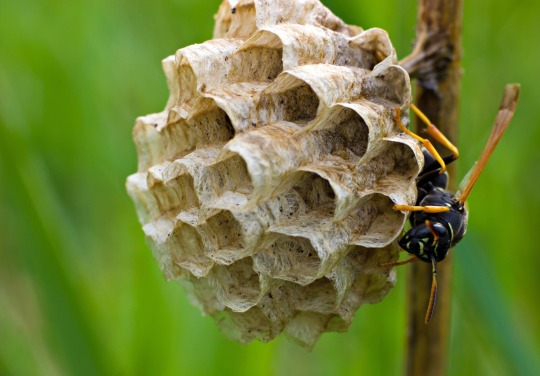
#animal facts#animals#facts#random facts#wasps#wasp#wasp nest#wasp nests#wasp facts#wasp fact#insects#insect#insect facts#insect fact#queen wasp
230 notes
·
View notes
Text
Uncharismatic Fact of the Day
With Chrysina limbata around, you won’t need a mirror! This species has an especially shiny exoskeleton, reflecting up to 97% of the light that hits it. In the wild, the mirror-like reflective surface may fool potential predators into thinking the beetle is just a drop of water- effectively serving as conspicuous camouflage.

(Image: Close-ups of Chrysina limbata by Michael Farmer)
If you like what I do, consider leaving a tip or buying me a ko-fi!
#Chrysina limbata#Coleoptera#Scarabaeidae#jewel scarabs#scarab beetles#beetles#insects#arthropods#uncharismatic facts
14K notes
·
View notes
Text
Nobody talks about the termites killed by anteaters...... it's right there in the name. ANT eaters. No one even cares that they eat more termites than ants. There's a stigma
28K notes
·
View notes
Text
Wool-Carder Bees: these solitary bees harvest the soft, downy hairs that grow on certain plants, rolling them into bundles and then using the material to line their nests

Wool-carder bees build their nests in existing cavities, usually finding a hole/crevice in a tree, a plant stem, a piece of rotting wood, or a man-made structure, and then lining the cavity with woolly plant fibers, which are used to form a series of brood cells.
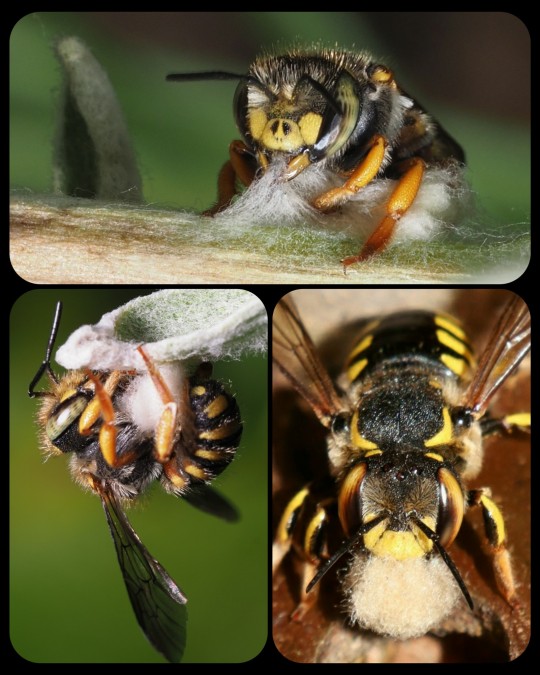
The fibers (known as trichomes) are collected from the leaves and stems of various plants, including lamb’s ear (Stachys byzantina), mulleins, globe thistle, rose campion, and other fuzzy plants.

From the University of Florida's Department of Entomology & Nematology:
The female uses her toothed mandibles to scrape trichomes off fuzzy plants and collects a ball of the material under her abdomen. She transports these soft plant fibers to her selected nest site and uses them to line a brood cell. Next, she collects and deposits a provision of pollen and nectar into the cell, enough pollen to feed a larva until it is ready to pupate. Lastly, she lays a single egg on top of the pollen and nectar supply before sealing the cell. ... She will repeat this process with adjoining cells until the cavity is full.
These are solitary bees, meaning that they do not form colonies or live together in hives. Each female builds her own nest, and the males do not have nests at all.
Female wool-carder bees will sometimes sting if their nest is threatened, but they are generally docile. The males are notoriously aggressive, however; they will often chase, head-butt, and/or wrestle any other insect that invades their territory, and they may defend their territory from intruders up to 70 times per hour. The males do not have stingers, but there are five tiny spikes located on the last segment of their abdomen, and they often use those spikes when fighting. They also have strong, sharp mandibles that can crush other bees.
There are many different types of wool-carder bee, but the most prolific is the European wool-carder (Anthidium manicatum), which is native to Europe, Asia, and North Africa, but has also become established as an invasive species throughout much of North America, most of South America, and New Zealand. It is the most widely distributed unmanaged bee in the world.
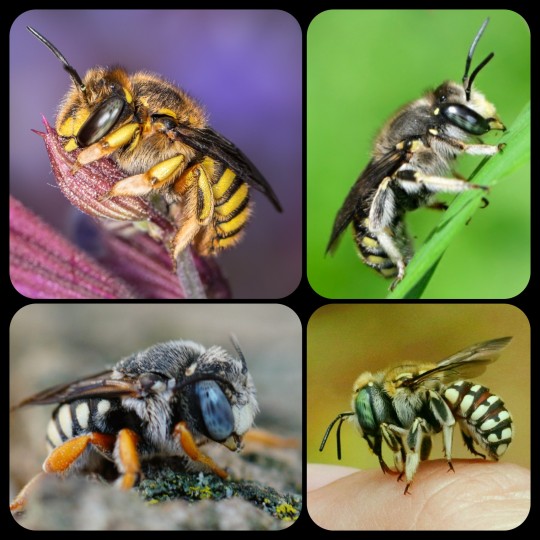
A few different species of wool-carder bee: the top row depicts the European wool-carder, A. manicatum (left) and the spotted wool-carder, Anthidium maculosum (right), while the bottom row depicts the reticulated small-woolcarder, Pseudoanthidium reticulatum, and Porter's wool-carder, Anthidium porterae
Sources & More Info:
University of Florida: The Woolcarder Bee
Oregon State University: European Woolcarder Bees
Bohart Museum of Entomology: Facts about the Wool Carder Bee (PDF)
Bumblebee Conservation Trust: A. manicatum
World's Best Gardening Blog: European Wool Carder Bees - Likeable Bullies
Biological Invasions: Global Invasion by Anthidium manicatum
#entomology#hymenoptera#apiology#melittology#bees#woolcarder bees#nature#insects#arthropods#science#solitary bees#european woolcarder#anthidium#animal facts#cool bugs#cute animals
3K notes
·
View notes
Text
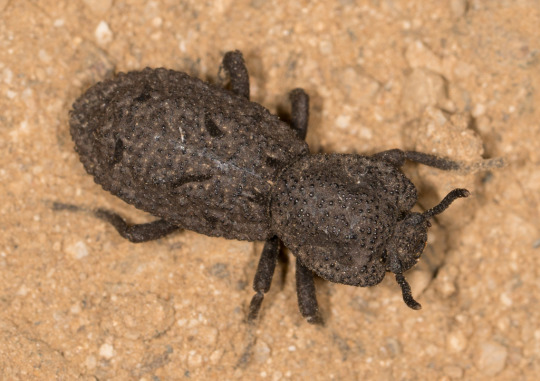
Fun fact: The diabolical ironclad beetle traded away the ability to fly in order to become essentially unsquishable.
Driving a car over them would just push them down into the dirt, still whole. Trying to stick a pin through wouldn't be successful without a drill. These guys are tough.
Every part of the beetle's exoskeleton seems to enhance its armor. The flattened body shape distributes pressure to even the load, the multilayered material is strong yet flexible enough not to crack, and the unique interlocking seams between wing cases function better than most joins designed by humans:


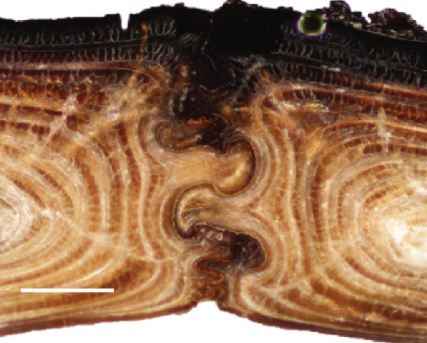
It'll be exciting to see what new materials might be possible using these concepts!
Sources: Jesse Rorabaugh, Po-Yu Chen, & Jesus Rivera et al.
#they really put all their stats into defense#long post#fun facts#beetles#insects#diabolical ironclad beetle#bugblr
3K notes
·
View notes
Text
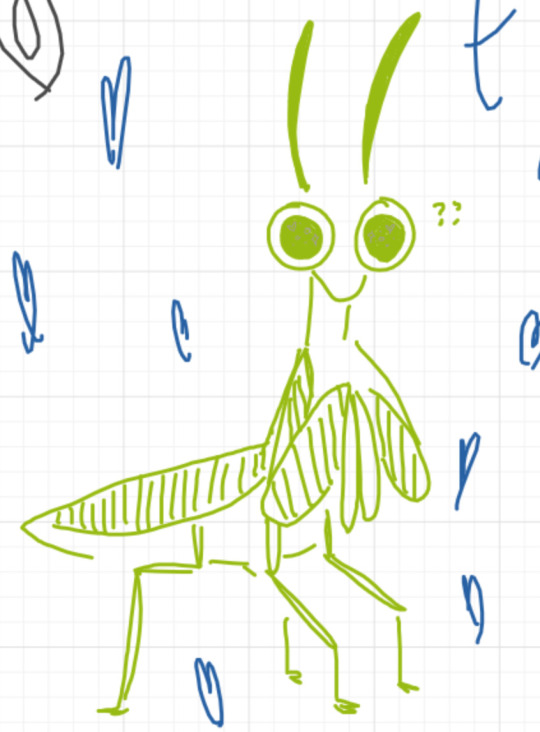


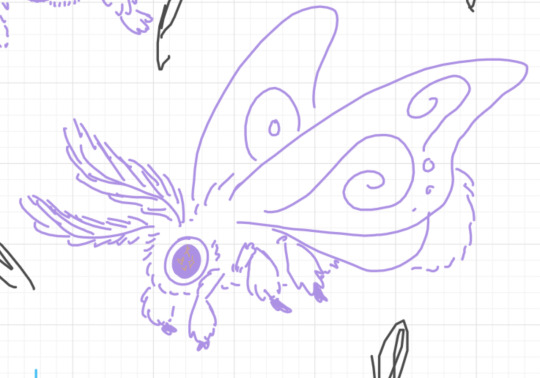
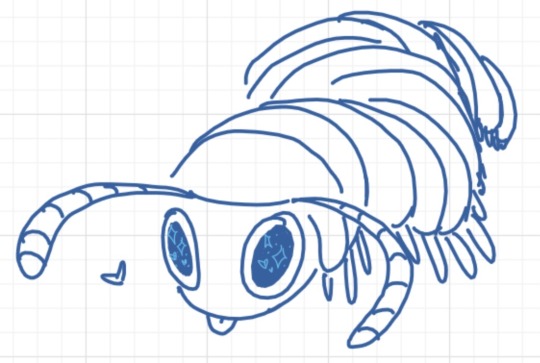
WHITEBOARD BUGS!!!!
#i love drawing lil cute bugs fun fact#my school notebooks were Littered with honeybees#i enjoy it! theyre cute! its soothing!#i like giving them cute lil tongues! Blep!#scribble salad#bugs#insects#digital art#im developing a deep fondness for millipedes#i had another one in my house the other day! a Guest!#i finally fulfilled my dream of holding one <3#theyre so cute.... little train bugs... choo choo....
881 notes
·
View notes
Text

modern au crack-ish yandere idea. dragons being the king of all lizards, imagine zhongli being able to control all the 'lesser' lizards to some extent, maybe even share senses with them.
and what better way for him to watch you, his dearest darling, than connecting with the common house geckos that's roaming around your house?
they're harmless, agile, and inconspicuous enough to do some basic monitoring. don't pay attention to the strange amber-eyed tiny animal perched on your bedroom walls, dear. don't delude yourself into thinking that its eyes seemed to shine in the darkness of your room while you teeter between dream and reality deep into the night. don't worry about how it seemed to chirp angrily whenever your friends come over, as if it's warning them from entering its territory.
it's just a common house pet anyway. right?
if you're a superstitious person, that's even better. geckos are said to be a symbol of luck, protection of your home and its residents. and in this case, it's especially true for you.
worry not, for this 'lizard' will gladly rid all the 'insects' who dared to step into your abode.

a/n: lil background story time. i needed to change my bedsheets and got utterly spooked by a tiny lil house lizard flopping onto my arm when i was moving my plushies to my desk. zhongli... honey... lizards are cute, yes, but you're the only lizard i don't mind having in my bedー /smacked
#yandere#genshin impact#genshin x reader#zhongli x reader#zhongli#rin releases a plot bunny into the wild#i haven't written in weeks and this idea just hit me out of nowhere what is this lmao#fun fact i have a very noisy home gecko after moving into this new house. it moved in after like my first week here i think. i'd also hear-#-it rummage through the bin at night hsjdhskdjsl#i just let it be bc no spiders and less insects in the room yay#also back in my house there's a very noisy gecko#it always chirps past midnight#adorable creatures i love them
721 notes
·
View notes
Text
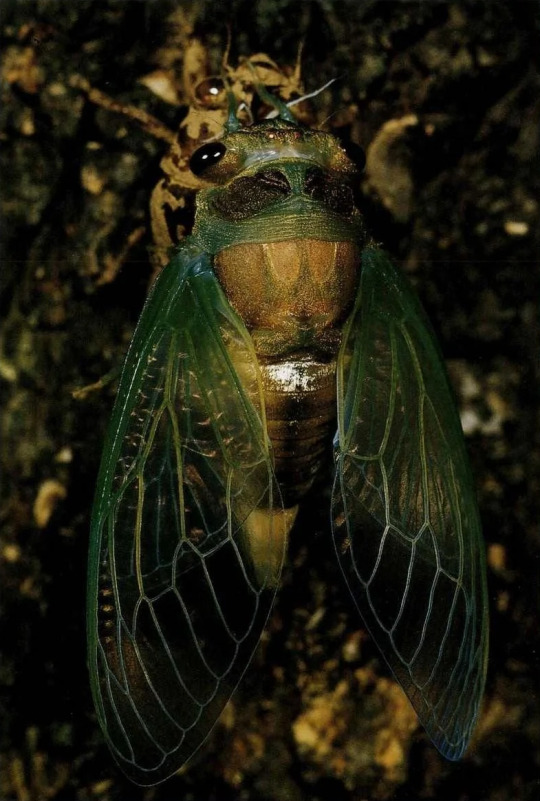
Cicada
By: Unknown photographer
From: Wildlife Fact-File
1990s
320 notes
·
View notes
Text



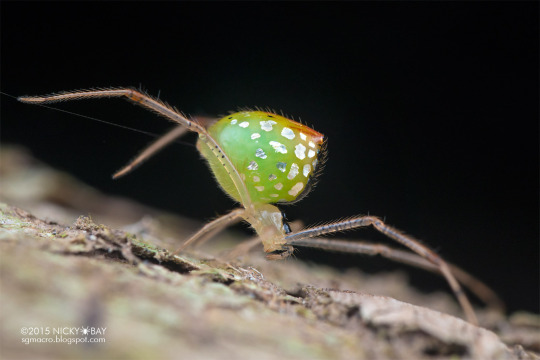
Thwaitesia argentiopunctata known as the sequined spider, mirror spider, or twin-peaked Thwaitesia, is a species of spider found in almost all states of Australia.
It is known to have a reflective abdomen that plays a crucial role in their camouflage to protect them from predators in the forest canopy.
The scales look like solid pieces of mirror glued to the spider's back, but they can actually change size depending on how threatened the spider feels. The reflective scales are composed of reflective guanine, which these and other spiders use to give themselves color.
[A-Z Animals: Sequined Spider]
#original post#fauna#Thwaitesia argentiopunctata#mirror spider#sequined spider#spider#insect#bio#biology#bioscience#bioblr#science#scienceblr#entomology#arachnids#invertebrates#bugs#bugblr#fun facts#nature#infopost
1K notes
·
View notes
Text
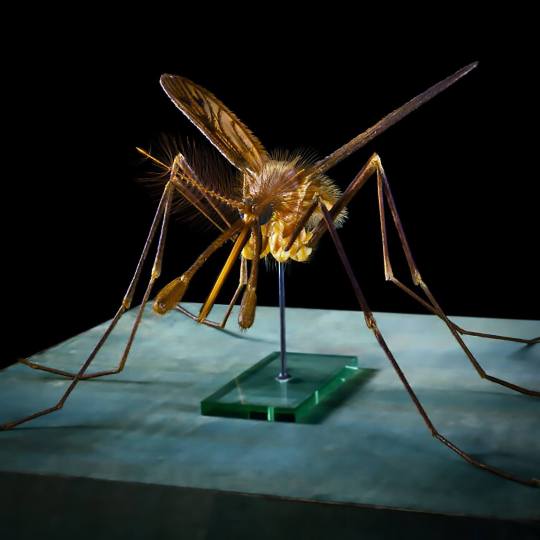
Have you ever noticed this gigantic mosquito at the Museum?
This isn’t a specimen of some monstrously-sized insect, but instead a scaled-up model of the tiny Anopheles maculipennis. This mosquito model is enlarged 47 times and debuted at the Museum in 1917 as part of an effort to educate the public about mosquito-borne illnesses like malaria and yellow fever.
Of the more than 3,500 species of mosquito known to science, the Anopheles mosquito is among a small handful responsible for malaria transmission in humans. While only females bite and transmit disease to humans, this model is a male.
At the time, it was a somewhat controversial idea that the mosquito, not poor sanitation, spread malaria. Since the model’s unveiling at the Museum, huge advances have been made in the global effort to combat and treat malaria as well as to educate the public about the disease.
Photo: © AMNH
328 notes
·
View notes
Text
Did you know, that hornets are actually quite peaceful insects? Hornets are much more tame than the common wasp as they only attack when someone or something is within a certain radius to their hive and they feel threatened. Otherwise, they are great pollinators and predators to other insect pests that are harmful to gardens.
It is improbable that they will sting as long as they are left alone.
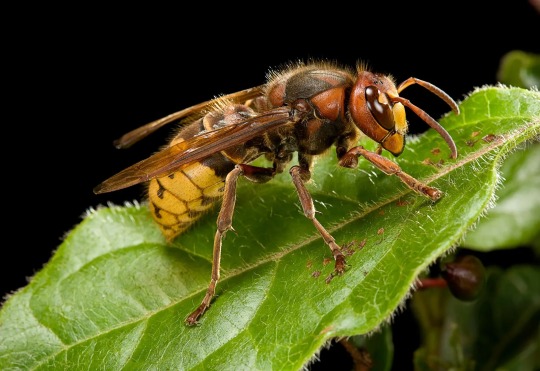
#animal facts#animals#facts#random facts#insect facts#insect fact#insects#insect#hornet#hornet facts#hornet fact
9 notes
·
View notes
Text

387 notes
·
View notes
Text
Uncharismatic Fact of the Day
As tasty as we humans might seem to some species of mosquito, there are many other species that simply aren't interested in us! For example, the mosquito Uranotaenia sapphirina much rather prefers the taste of worms and leeches, and can be found using their long proboscises to probe the ground for a potential meal.

(Image: Female Uranotaenia sapphirina feeding on earthworms by Dr. Lawrence Reeves)
If you like what I do, consider leaving a tip or buying me a kofi!
793 notes
·
View notes
Text

Footprints left behind by a ladybug.
#interesting#interesting facts#nature is weird#nature is everything#nature#discover#thats interesting#thats insane#thats incredible#like woah#lady bug#ladybug#bug#bugs#whatthe#what the#what#what the hell#whatever#what the fuck#insect#insects#woah#woahhhh#woah :0#woah dude#but woah#woah woah woah#woahg#thatscool
296 notes
·
View notes
Text
The Camouflaged Looper: these caterpillars fashion their own camouflage by collecting flower petals/vegetation and using silk to "glue" the pieces onto their bodies
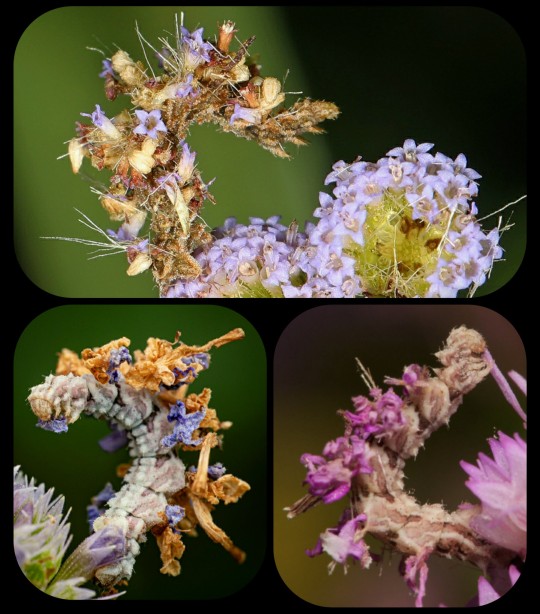
Often referred to as "camouflaged loopers," the caterpillars are the larvae of the wavy-lined emerald moth (Synchlora aerata).
Camouflaged loopers deploy a unique form of self-defense -- they snip off tiny pieces of the flowers upon which they feed, then use bits of silk to attach the vegetation to their backs. This provides them with a kind of camouflage, enabling them to blend in with the plants that they eat.

Some of them create little tufts that run along their backs, while others fashion a thicker camouflage that covers their backs completely. In some cases, the camouflaged loopers will even build much larger bundles that surround their entire bodies.
Their range includes most of North America (from southern Canada down through Texas) and they can feed upon an enormous variety of plants, so the disguises that these caterpillars build can come in countless colors, shapes, and sizes, incorporating many different flowers and other plants.

And this is what the fully-developed moth looks like:
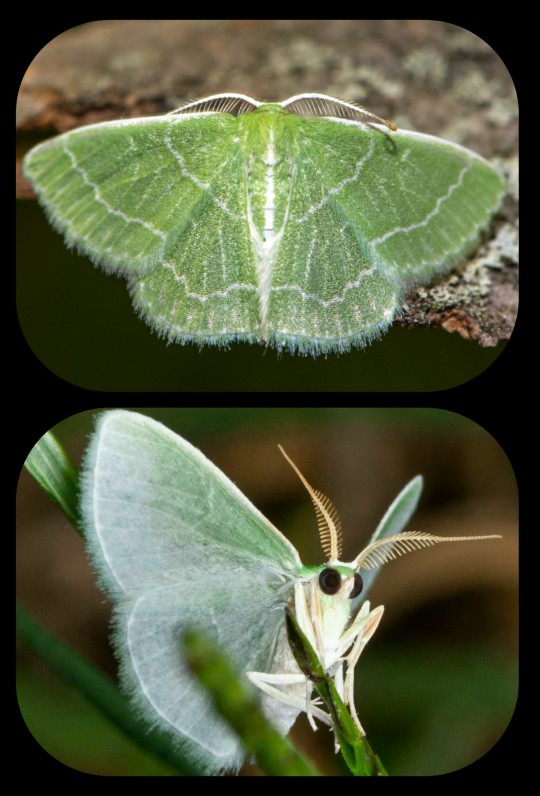
Sources & More Info:
Loudoun Wildlife Conservancy: Wavy-Lined Emerald, Master of Disguise
Maryland Biodiversity Project: Wavy-Lined Emerald Moth (Synchlora aerata)
The Caterpillar Lab: Camouflaged Looper
University of Alberta Museums: Synchlora aerata
Missouri Department of Conservation: Wavy-Lined Emerald
Nebraskaland Magazine: The Amazing Camouflaged Looper
Lake County Forest Preserves: Camouflage Revealed
#lepidoptera#moths#insects#caterpillar#camouflaged looper#animal camouflage#cute bugs#tw bugs#fashion#nature is weird#animal facts#these literal larvae have better fashion sense than I do
7K notes
·
View notes
Text

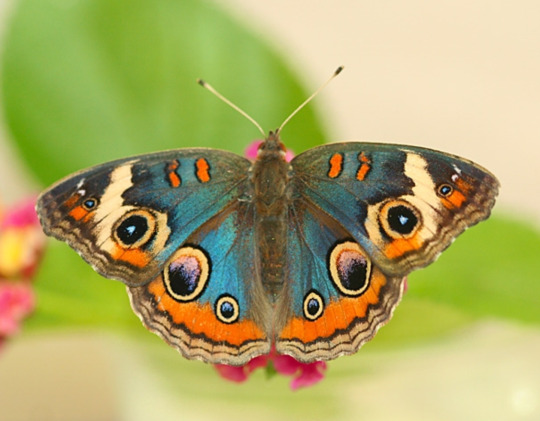
Fun fact: common buckeye butterflies (Junonia coenia) can be selectively bred to be blue fairly easily!
It turns out the only thing needed to go from brown to blue is a slightly thicker lamina, which is a flat layer at the bottom of the wing scale:
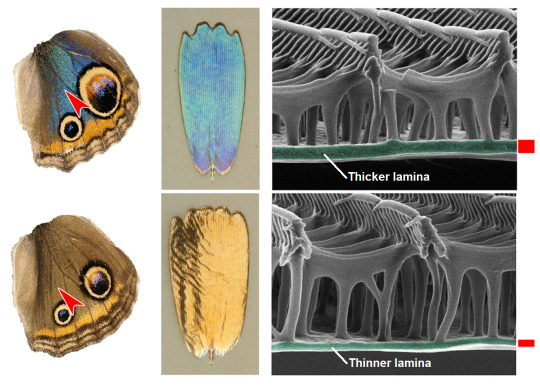
The lamina's iridescence is caused by the same phenomena as soap bubbles: thin-film interference. When light hits the transparent film of the lamina, it reflects off both the top and bottom of the layer.
Depending on the thickness and refractive properties of the material, the two reflected light waves can be in sync (image below) or cancel each other out. At the perfect thickness, the blue waves of light are enhanced and the butterfly becomes iridescent!

Because the difference in thickness needed to cause iridescence is so slight, it took less than a year to shift a population from just a few blue scales to full-on fabulous blue.
Photos & figures by Rachel Thayer, Nipam Patel, and Edith Smith.
#fun facts#structural color#iridescence#butterflies#buckeye butterfly#insects#bugblr#I just love shiny bugs
3K notes
·
View notes